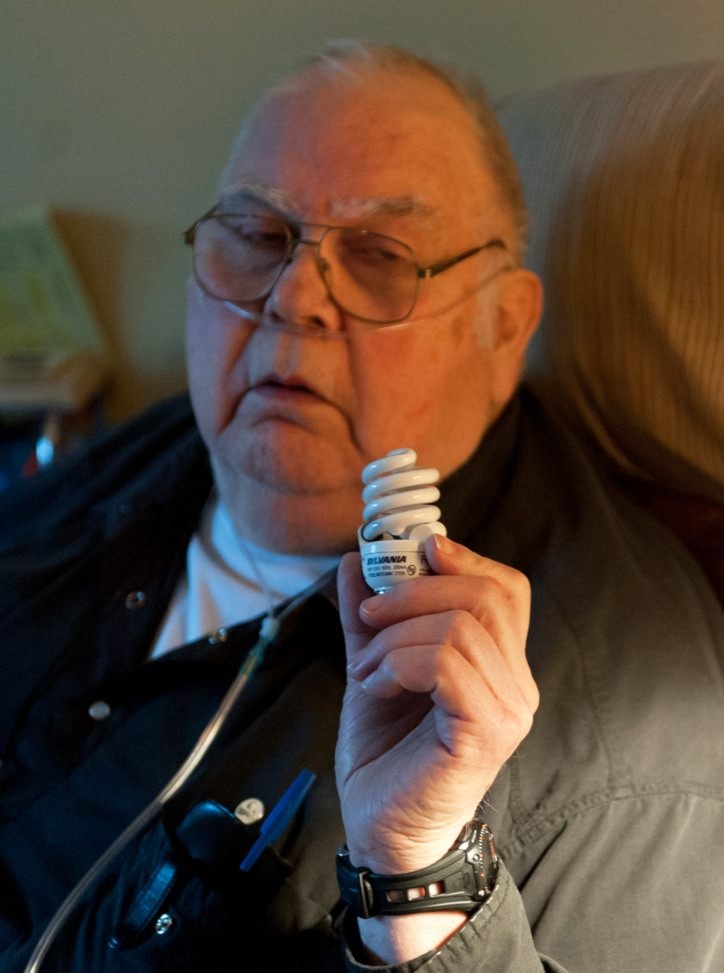PORT HARDY—A Port Hardy retiree outfitted his apartment with compact-fluorescent light bulbs in part to help save the environment.
After a bulb failure in his bedroom lamp left him in hospital overnight last week, 72-year-old Allan Lyon is more concerned with saving himself.
"I've started my own little campaign on getting rid of these things," said Lyon, back home and sitting in his living room chair Friday while holding a blackened and partly melted 13-watt Sylvania compact fluorescent lamp (CFL). "If I'd been asleep when that happened, I'd never have woke up."
Lyon was getting ready for bed last Wednesday evening when he noticed a strange odor in the hallway leading to his bedroom. It got stronger as he entered the room, but he could not determine its source until he reached for his bedside lamp and noticed white smoke rising from inside.
"I followed it up and saw a layer on the ceiling three or four inches thick," said Lyon, who is disabled and on oxygen due to a damaged chamber in his heart resulting from an industrial accident years ago.
He was surprised upon touching the lampshade to find it too hot to touch. When Lyon carefully reached under the hood to switch off the light, it flashed brightly and went out as soon as he contacted the switch.
"I tipped up the lamp to look underneath and the whole thing was glowing white," said Lyon, who waited until the lamp finally cooled enough to touch and then removed the helical, mini-style bulb.
That's when he found one of the collars connecting the base to the glass tube was blackened, part of the glass had dripped before re-solidifying, and the top of the bulb itself had swelled ominously.
"I've never seen glass hanging in drips like that, or blown up like that, unless it's heated with a torch," Lyon said.
As he pondered the overheated bulb, the problem of the smoke on the ceiling remained.
"I stood up to open the bedroom window to get it out of there, because of the bad smell," he said. "As soon as the window opened (the smoke) flowed down. I got a whiff of that and the next thing I remember is waking up on the bed."
Lyon called his neighbour, Verna Henderson, who took him to Port Hardy Hospital's emergency room. There, he says, he was placed on oxygen therapy for an hour before being admitted overnight for observation.
"This oxygen runs at two litres a minute," he said, point to the tube from his compressor. "In there they were giving me nine, to flush out my lungs."
He is still not sure exactly what he breathed in that evening, but won't be having any more of it. Upon returning home Thursday, the first thing he did was reopen the bedroom window and the front door and turn on a fan to try to clear the chemical smell that still remained in the apartment.
The second thing was to remove every compact fluorescent bulb from the home.
"They all bit the dust," said Lyon. "I purposely got these because of the ads on TV, put out by the government, that said they would use less power and are more environmentally friendly. When you investigate that, it's a crock.
"There's mercury inside these things, which is a deadly poison. So how do you list that as environmentally friendly?"
Two days after the incident, Lyon was still suffering a sore throat, painful swallowing and a "funny feeling" in his nose. He called Sylvania Thursday and was told a company vice president would get back to him Friday morning. That afternoon, he was still waiting for a reply.
He was asked during the call whether the bulb was rated higher than the lamp in which it was placed.
"The lamp that I have is rated for 60 watt, and this one here says it's 13 watt," Lyon said. "So the lamp was definitely not over-lit."
Health Canada reports the primary health concern from CFLs is to people susceptible to prolonged exposure to the UV light emitted from the lamps. But its website includes a link to a 2007 report from the Electrical Safety Authority, responding to consumer concerns about CFLs, that admits end-of-life failure of the bulbs can include emissions of smoke and odour, popping sounds and discolouring or deformation of the light's base.
"Certification agencies have advised that this failure does not present a shock or fire hazard for approved products," the ESA report stated.
The Federal Government, meanwhile, has instituted a national standard for lighting efficiency, effective this year, that will essentially render obsolete the existing incandescent bulbs. Most of these bulbs will not meet the efficiency level, and will be replaced in stores by CFLs, enhanced halogen lights and others still in development for use in Canada.
"The government is trying to force us to use these," Lyon said, holding up his melted bulb. "I called around and found Home Hardware had a bunch of the (incandescent) 60-watts. I bought 'em out."
